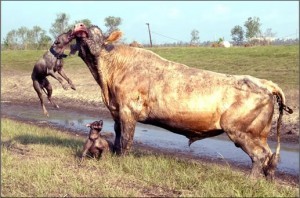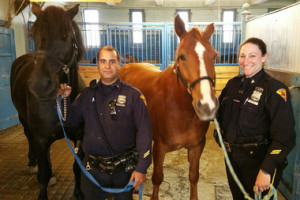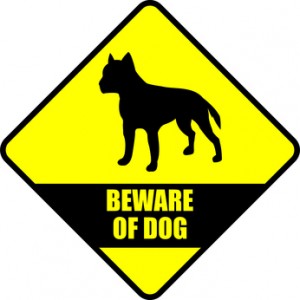PIT BULL ATTACKS NYPD OFFICER’S POLICE HORSE IN BROOKLYN
EAST NEW YORK (WABC) — An NYPD police horse is recovering after being attacked by a pit bull in Brooklyn Wednesday.
Officer Luis Ramos and his horse Pompey II were en-route to the 75th Precinct on Sutter Avenue in East New York.
In the vicinity of Essex Street, police say the pit-bull charged at Pompey II, biting the stallion in the right chest area and his inner left leg, causing puncture wounds and abrasions.
Pit Bull Attacks Police Horse in East New York, Police Say
By Ben Fractenberg | April 22, 2015 7:08pm
Mounted officer Laurene Bove was riding her horse, Limerick, nearby when she witnessed the attack and came to aid Pompey II.
The officers eventually got the dog to retreat back into the yard at 490 Essex St., where the owner was able to grab the pit bull.
NYPD horse attacked by pit bull
Updated April 22, 2015 8:31 PM – By ANTHONY M. DESTEFANO [email protected]
The owner of the pit bull, who wasn’t identified, was able to secure the dog. The canine was taken to a local New York Animal Care & Control, or ACC, facility where it will be evaluated, according to police. An NYPD spokesman didn’t know if the dog was up-to-date on its vaccinations. A spokesman for ACC didn’t immediately return an email for comment.
Police Horse Recovering After Pit Bull Attack
ALISON FOX ON APR 23, 2015 – SOURCE: AMNEWYORK, NEW YORK
A police horse is recovering with “a few extra apples and carrots” after being bitten twice by a pit bull on Wednesday while on patrol in the East New York area of Brooklyn, police said.
Pompey II was taken back to the stables in Brighton Beach, Brooklyn, where he was treated by a veterinarian. He is expected to make a full recovery after a few days’ rest.
American Pit Bull Terrier
 The ‘bull and terrier’ type was originally developed in England in the early 19thcentury. The lineage goes back to the mastiff / molosser types, including what we now call the Olde English Bulldogge, that were used for bear-, bull- and horse-baiting from the 12th through the 18th century. This isn’t the bear-baiting we think of today, when hunters feed bears in order to bring them out in the open to shoot them. Rather, the bear, bull or horse was confined in a public arena where the mastiff ‘bulldogs’ would slowly tear them apart alive for the public’s amusement1,2,3,4,5.
The ‘bull and terrier’ type was originally developed in England in the early 19thcentury. The lineage goes back to the mastiff / molosser types, including what we now call the Olde English Bulldogge, that were used for bear-, bull- and horse-baiting from the 12th through the 18th century. This isn’t the bear-baiting we think of today, when hunters feed bears in order to bring them out in the open to shoot them. Rather, the bear, bull or horse was confined in a public arena where the mastiff ‘bulldogs’ would slowly tear them apart alive for the public’s amusement1,2,3,4,5.
The popularity of this ‘sport’ declined as education became more emphasized in urban society of the Industrial Revolution and literacy among the population grew (from about 30% in the 17th century to 62% by 1800)6. The ‘sport’ was banned altogether by Act of Parliament in 1835.
The lovers of blood ‘sports’ turned to dogfighting to satisfy their fancy, breeding the large, mastiff-type bulldogs to smaller working terriers to get dogs both smaller and more agile, easier to keep and to hide, but just as willing to attack and fight to the death. With the rise of the kennel clubs and the desire to distinguish dogs by looks and pedigree as well as by performance, this ‘bull and terrier’ type eventually divided into many official breeds. They all share the same ancestry and function, distinguishing themselves mostly by slight differences in appearance.
The American Pit Bull Terrier is, like all the ‘bully’ breeds, one of this group of descendants of the British ‘bull and terrier’ type fighting bulldogs. Once imported into the United States, it was bred up to be bigger again, and again used in baiting animals and in dogfighting. The American Kennel Club (founded 1884) was unwilling to register these fighting dogs, so in 1898 the United Kennel Club was founded specifically to register working pit-fighting dogs and to promote dogfighting. In order to be registered, a dog had to first win three pit fights7,8,9. The American Pit Bull Terrier (APBT) became a ‘breed’. As dogfighting declined in popularity in the 1930s and 1940s, Colby (the most famous and prolific breeder of these dogs) began to search for a new market and began promoting the APBT as family pets10,11. This despite the fact that his breeding lines included child killers12.
Click here to read more about the American Pit Bull Terrier
How many other animals did pit bulls kill in 2014?
Fifty thousand dogs per year, including at least 34,250 pit bulls, attack other animals, according toANIMALS 24-7 analysis of dog attack data from 2013-2014.
Of the 82,000 animal victims per year, 59,000 die; 23,000 survive their injuries. Among the dead are 15,500 dogs, 95% of them attacked by pit bulls, and 6,000 hooved animals, 93% of them attacked by pit bulls.
Pit bulls also inflict at least 60% of the 29,000 fatal attacks on domestic birds and small mammals, and at least 60% of the 8,250 fatal attacks on cats. About a third of the fatal dog attacks on domestic birds, small mammals, and cats are by dogs who are not caught and identified, so might also include many pit bulls.
POTENTIALLY DANGEROUS DOG BREEDS
This is a list of dog breeds that have a history of being potentially dangerous to people, especially children. Daxton’s Friends for Canine Education and Awareness understands that any dog has the ability to bite or inflict serious harm to humans. This list consists of several dog breeds that have a higher than average number of recorded human fatalities. Please use extreme caution if you choose to bring one of these breeds into your home. Rental communities and homeowners insurance may restrict many of the dog breeds on this list due to the likelihood of a serious incident.
Pit Bulls, Mastiff, and Rottweiler lead in fatalities and are listed first. The rest of the breeds are listed in alphabetical order:
- American Bulldog
- American Pit Bull Terrier
- American Staffordshire Terrier
- English/Standard Bull Terrier
- Miniature Bull Terrier
- Olde English Bulldog
- Staffordshire Bull Terrier
Mastiffs
- Bullmastiff
- Cane Corso/Italian Mastiff
- Dogo Argentino
- English Mastiff
- Fila Brasileiro
- Dogue de Bordeaux/French Mastiff
- Great Dane/German Mastiff
- Presa Canario
- St. Bernard/Alpine Mastiff

 –
– 
